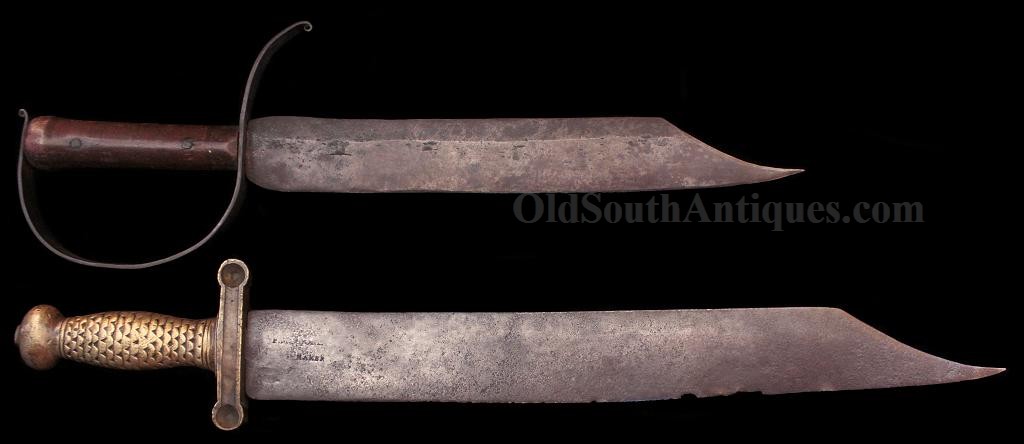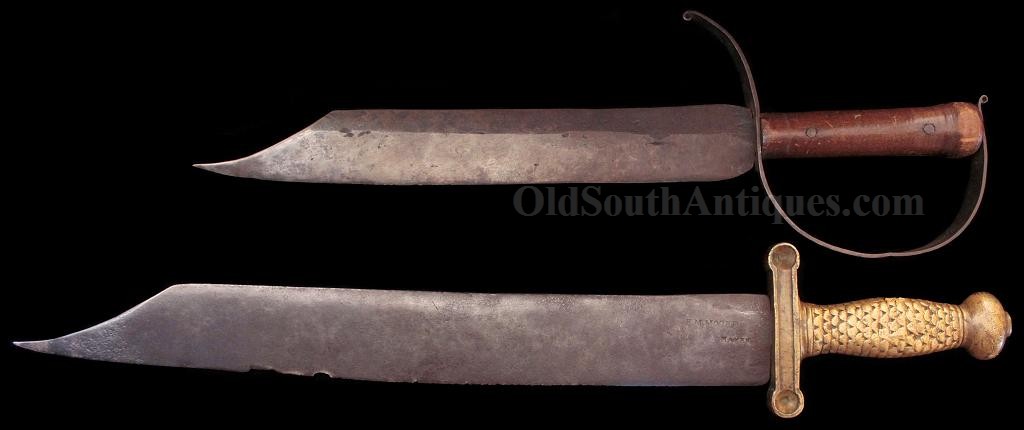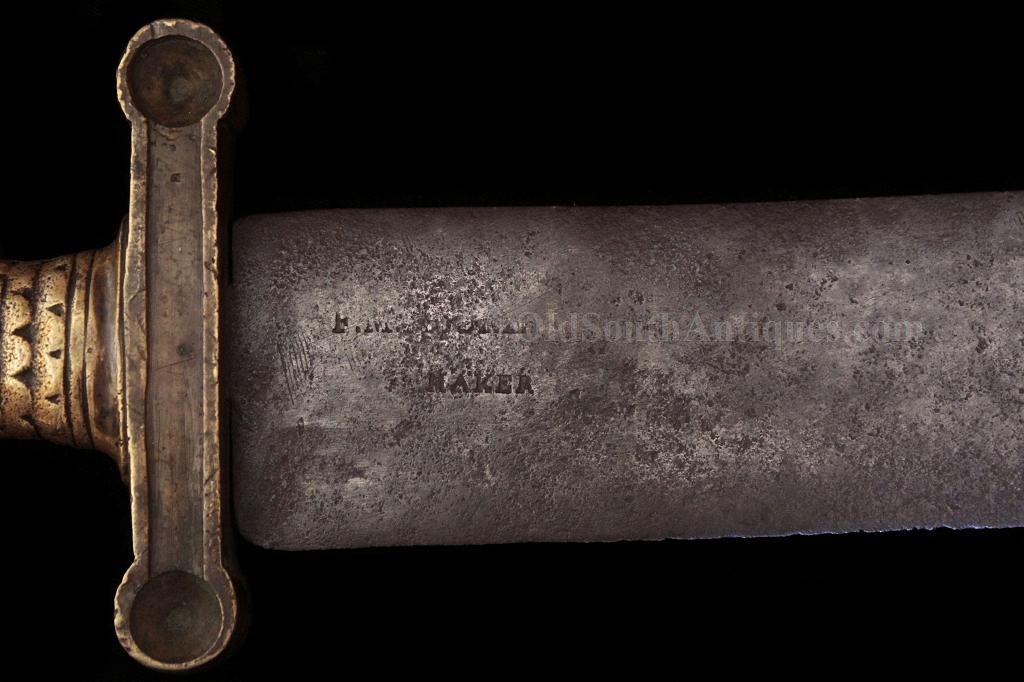
| Catalog | Past Items | Order Info | Terms/Conditions | About Us | Inventory Clearance |
The most desirable and valuable Confederate knives are those identified by a maker’s mark, those identified to a specific maker, and those identified to a specific soldier. This is because we collect history. Sure, we collect items, but they are items that bring us closer to history and the specific identification of the maker or owner adds so very much history to a given knife.
Because the two knives shown here were identified by noted knife collector John Ashworth, they were included in Confederate Bowie Knivesby Phillips and Melton, on page 189. The example with the Memphis Novelty Works brass handle was discovered in the 1980s in Moore’s home/shop which was being demolished in Memphis, Tennessee, so this was his family’s personal knife. The 1859 Memphis City Directory lists Franklin M. Moore as a blacksmith, as does his 1850 census records. His shop was only a few blocks from the Memphis Novelty Works and he no doubt acquired the grip, or pattern, from the firm.
The 23 ½ inch monster knife is as tight as the day it was made. Moore took the trouble to stamp his moniker in both sides of the slant point blade. There are only two knives known with this blade design and it is clear from the shape of the blade and the point that the D guard, though unmarked, was made by Moore also. The large 18 5/8 inch D guard is also published on page 189 of Confederate Bowie Knives by Phillips and Melton. It too is as tight as the day it was made. Neither knife has been cleaned nor altered in any way.
Frank Moore was a 25-year-old blacksmith on Union Street in Memphis when he enlisted October 19, 1861, into Company H, Jones’ West Tennessee Battalion. On February 2, 1862 (Brown’s) 55th Regiment Tennessee Volunteers was organized by order of General Leonidas Polk, who transferred the seven companies of the West Tennessee Battalion to the new regiment and assigned to it the other three companies. Frank’s brother Alfred served in the same regiment until he was shot through the brain in late 1861 while guarding prisoners.
Brown’s 55thTennessee Regiment remained at Columbus, Kentucky, until March 1862, when it was ordered to Island Number 10 where it fought through the severe bombardment. On March 17th, Brigadier General I. Trudeau, commanding the Heavy Artillery, placed Brown’s Regiment on the parapet, in support of Captain Rucker’s Battery. He reported some "men from Brown’s Regiment had relieved Captain Rucker’s exhausted men, and served the guns bravely, manfully and intelligently. They had done good and efficient service on that day.”
On March 21st, the 55th reported 327 present for duty, 402 present. When Brigadier General W. W. Mackall arrived on April 1st he reported Colonel Brown’s 55th Tennessee having but few arms and those of "different kinds.”
Frank and most of his regiment was captured at Island Number 10, on April 8, 1862. He was confined in the notorious Camp Douglas Prisoner of War Camp in Illinois. Fortunately, the Southern boy did not have to spend the winter in the Yankee death camp; he was sick in the prison hospital the following September; a hospital that was dreaded by the Confederates because of the high death rate. Frank and the remainder of his regiment were placed on board the steamer John H Done, and transported close to Vicksburg in September 1862, where they were released on parole and declared exchanged November 10, 1862. In the meantime, the regiment had reorganized at Jackson, Mississippi, September 26, 1862. From October 1862 to January 1863, the regiment was temporarily consolidated with the 49th Tennessee and 7th Texas to form a field unit known as Bailey’s Consolidated Regiment.
On January 7, 1863, a brigade was formed by consolidating the 42nd, 46th, 48th, 49th, 50th, 53rd, and 55th Tennessee Regiments at Port Hudson, Louisiana. On March 14th, the men faced a sustained, severe bombardment by Commodore Farragut.
They marched out of Port Hudson headed for Jackson, Mississippi but arrived after Grant had captured Jackson, Mississippi. They fought in the battles and skirmishes around Jackson, Mississippi between July 10th and the 16th.
Frank’s surviving muster roll dated July 1863 shows him present. He was placed on detached service with the General Hospital, Lauderdale Springs, Mississippi. His last surviving roll dated September 1863 shows him still a member of Company H, 55th Tennessee Infantry, but detailed as a nurse at the General Hospital, Lauderdale Springs, Mississippi. No more of Frank’s muster roll records survive, but he survived the War, went home and became a very well respected businessman and citizen. He could not have done this had he deserted, so I assume he was with his regiment most of the time until the surrender.
The 55thwas ordered to Missionary Ridge from Mobile, but arrived too late for the battle, when they were "ordered into battle, it was too late, as our army had been defeated.”
They fell back with Army of Tennessee to Dalton, Georgia and on Dec. 14, 1863, they had 180 effective men capable of combat or 227 present. They had 220 arms in the regiment at that time.
The Congress of the Confederacy passed a resolution of thanks to the 46th/55th for "patriotism displayed in unanimously reenlisting for the war” on February 15th, 1864.
After moving to Georgia, they fought in the Battle of Resaca, May 13-15, 1864. They fought with Joseph E. Johnston at the Battle of New Hope Church, May 25th and 26th. They went back into battle June 15that the Battle of Pine Mountain, and again June 28th, at the Battle of Kennesaw Mountain.
On June 30th, they reported to the Army of Mississippi, Loring Brigade, Walthall Division in Georgia. They went into battle again on July 4th at Smyrna Depot and with little rest fought the Battle of Peach Tree Creek outside Atlanta on July 20th.
On July 28, 1864, the men fought at Lick Skillet Road during the Battle of Ezra Church, where they suffered the greatest losses that the regiment sustained in any engagement in the War, except perhaps Franklin. Their brigade went into the battle 913 strong and had 76 killed, 400 wounded and 19 missing, for a total of 495. The 55thlost "almost every officer killed and wounded.”
At the Battle of Franklin, Tennessee, November 30th, under Brigadier General Quarles, Walthall's Division, attacked right of center in as many as six distinct attacks. All of these assaults were turned back with heavy losses. The brigade of Brig. Gen. William A. Quarles charged through the abatis and reached the Federal earthworks, but here it was pinned down by murderous crossfire. Quarles was wounded in the left arm and at the end of the battle the highest-ranking officer standing in his brigade was a captain.
The Army of Tennessee was all but destroyed at Franklin. Nevertheless, Hood advanced his 26,500 man force against the Union army which now numbered more than 60,000. Hood and his department commander, Gen. P.G.T. Beauregard, requested reinforcements, but none were available. Heavily outnumbered and exposed to the elements, Hood was attacked by Thomas on December 15–16 at the Battle of Nashville and was defeated decisively and pursued aggressively. A muddy, exhausted and broken down army arrived in Mississippi with just under 20,000 men. The Army of Tennessee never fought again as an effective force.
After the severe loses at Franklin, the 42nd/46th/49th/53rd/55th were consolidated into one unit, the 4th Consolidated Regiment of Tennessee Infantry. The 4th fell back with Johnston through North Carolina and was surrendered and paroled at Greensboro with the Army of Tennessee.
Returning to his home after the War, Frank Moore became a very successful "blacksmith, carpenter, brick mason and machinist, and he had just invented a gin saw filing machine, for which he was preparing to obtain a patent that would file two gins per day. And besides he was about establishing a (new) machine shop and foundry on Vance Street.”[1] He operated a land development company known as Moore & Hughes and had become a large, urban property owner, when in the wee hours of July 27, 1873, Frank was shot in the head, inside his bedroom. His wife and nephew were arrested but were shortly released. Very much ink was expended on the case during 1873, with all sorts of theories as to who assassinated the prominent business man. The case would make a good book or motion picture with so many twists and turns. In 1881, his remarried widow was rearrested, based on her brother’s testimony. She had cheated her brother out of his life savings, and he wanted vengeance. Of course, the question arose as to whether the brother was telling the truth, or just seeking that vengeance. I eventually found so much information that I stopped looking for further details.
Because of the maker’s mark, we know that Frank Moore made these knives, perhaps for himself and his brother, and perhaps some few more for sale. Frank and his brother were both Confederate soldiers in the 55th Tennessee Volunteers and we know that the brass handled knife had just been discovered in Frank’s home when John Ashworth acquired it. So not only do we know the maker, we know the owner; the one and same, Private Frank Moore, Company H, 55thTennessee Volunteers.
I would like to see these knives stay together, and to facilitate that end, I will price the two at only 8400.00, which is an unheard of value for two maker identified knives, one of which is identified to the soldier.
Copyright © 2024 OldSouthAntiques.com All Rights Reserved.
Privacy Policy | Terms of Use
Powered by Web-Cat Copyright © 1996-2024 GrayCat Systems




